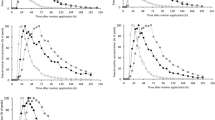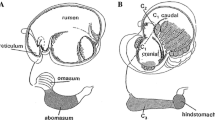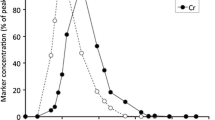Abstract
Whether differences in digestive physiology exist between different ruminant feeding types has been an ongoing debate. In this regard, potential differences in ingesta retention have been understood to be of particular importance. We analyzed a data pool in which only mean retention time (MRT) data for the ruminoreticulum (RR) were collated that were obtained using comparable techniques with either chromium or cobalt EDTA as a fluid marker and/or with chromium-mordanted fiber of less than 2 mm in size as a particle marker. Data were compared using one averaged value per species. In general, the paucity of species in such a collection is striking and does not allow—in contrast to earlier statements—any final conclusions regarding the influence of body weight (BW) or feeding type on ruminant MRTs. In particular, there was no significant correlation between MRTparticlesRR or MRTfluidRR and BW, neither in the interspecific nor in the intraspecific comparisons, and no difference between the feeding types. The trend that indicates longer MRTparticlesRR in grazers is based on too few species to be conclusive. Small browsers seemed to have shorter MRTfluidRR than similar-sized grazers. In contrast, there was a trend for large grazers to have shorter MRTfluidRR than large browsers. In direct pair-wise comparisons between cattle and the browsers giraffe, moose, and okapi, the latter difference was significant. Cattle also had the highest relative RR fluid outflow rates among the species investigated. This is in accord with the observation that grazers have larger omasa, a major function of which is water-reabsorption distal to the RR. Grazers seem to have longer MRTparticlesRR per unit MRTfluidRR, and cattle are particular outliers in this respect. It is hypothesized that potentially shorter MRTfluidRR in large grazers and higher relative outflow rates are linked to a higher saliva production and a lesser viscosity of both saliva and RR fluids. A constant supply of a fluid phase of low viscosity is proposed to be the prerogative for the physical mechanisms of flotation and sedimentation that result in the stratification of RR contents and its selective particle retention typical for large grazing species.





Similar content being viewed by others
References
Amici A, Bartocci S, Terramoccia S, Martillotti F (1997) Passage rate of solids and fluids in the digestive tract of buffaloes, cattle and sheep: selection of non-linear model. Anim Sci 64:63–69
Arthun D, Holechek JL, Wallace JD, Gaylean ML, Cardenas M (1992) Forb and shrub effects on ruminal fermentation in cattle. J Range Manage 45:519–522
Bailoni L, Ramanzin M, Simonetto A, Obalakov N, Schiavon S, Bittan G (1998) The effect of in vitro fermentation on specific gravity and sedimentation measurements of forage particles. J Anim Sci 76:3095–3103
Bartocci S, Amici A, Verna M, Terramoccia S, Martillotti F (1997) Solid and fluid passage rate in buffalo, cattle and sheep fed diets with different forage to concentrate ratios. Livest Prod Sci 52:201–208
Behrend A (2000) Kinetik des Ingestaflusses bei Rehen und Mufflons im saisonalen Verlauf. Dissertation, Berlin
Behrend A, Lechner-Doll M, Streich WJ, Clauss M (2004) Comparative faecal excretion, gut fill, and solute and particle marker retention in mouflon (Ovis ammon musimon) and roe deer (Capreolus capreolus). Acta Theriol 49:503–515
Branine ME, Galyean ML (1990) Influence of grain and monensin supplementation on ruminal fermentation, intake, digesta kinetics and incidence and severity of frothy bloat in steers grazing winter wheat pasture. J Anim Sci 68:1139–1150
Burns JC, Pond KR, Fisher DS, Luginbuhl JM (1997) Changes in forage quality, ingestive mastication, and digesta kinetics resulting from switchgrass maturity. J Anim Sci 75:1368–1379
Clarke RTJ, Reid CSW (1974) Foamy bloat of cattle. A review. J Dairy Sci 57:753–785
Clauss M, Lechner-Doll M (2001) Differences in selective particle retention as a key factor in the diversification of ruminants. Oecologia 129:321–327
Clauss M, Deutsch A, Lechner-Doll M, Flach EJ, Tack C (1998) Passage rate of fluid and particle phase in captive giraffe. Adv Ethol 33:98
Clauss M, Lechner-Doll M, Behrend A, Lason K, Lang D, Streich WJ (2001) Particle retention in the forestomach of a browsing ruminant, the roe deer. Acta Theriol 46:103–107
Clauss M, Lechner-Doll M, Streich WJ (2002) Faecal particle size distribution in captive wild ruminants: an approach to the browser/grazer-dichotomy from the other end. Oecologia 131:343–349
Clauss M, Lechner-Doll M, Streich WJ (2003) Ruminant diversification as an adaptation to the physicomechanical characteristics of forage. A reevaluation of an old debate and a new hypothesis. Oikos 102:253–262
Clauss M, Lechner-Doll M, Streich WJ (2004) Differences in the range of faecal dry matter content between feeding types of captive wild ruminants. Acta Theriol 49:259–267
Colucci PE, Macleod GK, Grovum WL, McMillan I (1984) Comparative digestion and digesta kinetics in sheep and cattle. Can J Anim Sci 64:173–174 (Suppl)
De Vaga A, Poppi DP (1997) Extent of digestion and rumen condition as factors affecting passage of liquid and digesta particles in sheep. J Agric Sci (Camb) 128:207–215
Demment MW, Van Soest PJ (1985) A nutritional explanation for body-size patterns of ruminant and nonruminant herbivores. Am Nat 125:641–672
Ditchkoff SS (2000) A decade since ‘diversification of ruminants': has our knowledge improved? Oecologia 125:82–84
Dixon RM, Milligan LP (1985) Removal of digesta components from the rumen of steers determined by sieving techniques and fluid, particulate and microbial markers. Br J Nutr 53:347–362
Edrise BM, Smith RH (1979) Absorption and secretion in the omasum of the young steer. Ann Rech Vet 10:354–355
Edrise BM, Smith RH, Hewitt D (1986) Exchanges of water and certain water-soluble minerals during passage of digesta through the stomach compartments of young ruminant bovines. Br J Nutr 55:157–167
Faichney GJ (1980) The use of markers to measure digesta flow from the stomach of sheep fed once daily. J Agric Sci (Camb) 94:313–318
Faichney GJ, Griffiths DA (1978) Behaviour of solute and particle markers in the stomach of sheep given a concentrate diet. Br J Nutr 40:71–82
Foose TJ (1982) Trophic strategies of ruminant versus nonruminant ungulates. Ph.D. Thesis, University of Chicago
Freudenberger DO, Burns CJ, Toyokawa K, Barry TN (1994) Digestion and rumen metabolism of red clover and perennial ryegrass/white clover forages by red deer. J Agric Sci (Camb) 122:115–120
Funk MA, Galyean ML, Branine ME, Krysl LJ (1987) Steers grazing blue grama rangeland throughout the growing season. I. Dietary composition, intake, digesta kinetics and ruminal fermentation. J Anim Sci 65:1342–1353
Goetsch AL, Galyean ML (1982) Effect of dietary concentrate level on rumen fluid dilution rate. Can J Anim Sci 62:649–652
Gordon IJ, Illius AW (1994) The functional significance of the browser-grazer dichotomy in African ruminants. Oecologia 98:167–175
Gross JE, Alkon PU, Demment MW (1996) Nutritional ecology of dimorphic herbivores: digestion and passage rates in Nubian ibex. Oecologia 107:170–178
Grovum WL, Williams VJ (1973) Rate of passage of digesta in sheep: III. Differential rates of passage of water and dry matter from the reticulo-rumen, abomasum and caecum and proximal colon. Br J Nutr 30:231–240
Gurnsey MP, Jones WT, Reid CSW (1980) A method for investigating salivation in cattle using pilocarpine as a sialagogue. NZ J Agric Res 23:33–41
Hatt JM (1996) Observations on the digestive strategies of giraffes in captivity. MSc Thesis, The Royal Veterinary College, Institute of Zoology, London
Hatt JM, Lechner-Doll M, Mayes B (1998) The use of dosed and herbage n-alkanes as markers for the determination of digestive strategies of captive giraffes. Zoo Biol 17:295–309
Hauffe R, von Engelhardt W (1975) Funktionen des Blättermagens bei kleinen Hauswiederkäuern. III. Resorption von Wasser. Zbl Vet Med A 22:283–295
Hendricksen R, Poppi D, Minson D (1981) The voluntary intake, digestibility and retention time by cattle and sheep of stem and leaf fractions of a tropical legume. Austr J Agric Res 32:389–398
Hjeljord O, Sundstol F, Haagenrud H (1982) The nutritional value of browse to moose. J Wildl Manage 46:333–343
Hofmann RR (1973) The ruminant stomach. East African Monographs in Biology, vol 2. East African Literature Bureau, Nairobi, Kenia
Hofmann RR (1989) Evolutionary steps of ecophysiological adaptation and diversification of ruminants: a comparative view of their digestive system. Oecologia78:443–457
Holand O (1994) Seasonal dynamics of digestion in relation to diet quality and intake in European roe deer. Oecologia 98:274–279
Hummel J (2003) Ernährung und Nahrungsaufnahmeverhalten des Okapis (Okapia johnstoni) in Zoologischen Gärten. Dissertation, Bonn
Iason GR, Van Wieren SE (1999) Adaptations of mammalian herbivores to low quality forage. In: Olff H, Brown VK, Drent RH (eds) Herbivores, plants and predators. Blackwell Science, Oxford, pp 337–369
Illius AW, Gordon IJ (1992) Modelling the nutritional ecology of ungulate herbivores: evolution of body size and competitive interactions. Oecologia 89:428–434
Jacques K, Harmon DL, Croom WJ, Hagler WM (1989) Estimating salivary flow and ruminal water balance of intake, diet, feeding pattern, and slaframine. J Dairy Sci 72:443–452
Jiang Z, Hudson RJ (1996) Digestive responses of wapiti to seasonal forages. Acta Theriol 41:415–423
Kaske M, Groth A (1997) Changes in factors affecting the rate of digesta passage during pregnancy and lactation in sheep fed on hay. Reprod Nutr Dev 37:573–588
Kattnig RM, Pordomingo AJ, Schneberger AG, Duff GC, Wallace JD (1992) Influence of saline water on intake, digesta kinetics, and serum profiles of steers. J Range Manage 45:514–518
Kay RNB (1987a) Comparative studies of food propulsion in ruminants. In: Ooms LAA, Degtyse AD, Van Miert ASJ (eds) Physiological and pharmacological aspects of the reticulo-rumen. Martinus Nijhoff, Boston, pp 155–170
Kay RNB (1987b) Weights of salivary glands in ruminant animals. J Zool (Lond) 211:431–436
Kennedy PM (1985) Influences of cold exposure on digestion of organic matter, rates of passage of digesta in the gastrointestinal tract, and feeding and rumination behaviour in sheep given four forage diets in the chopped, or ground and pelleted form. Br J Nutr 53:159–173
Kennedy PM, McSweeney CS, Welch JG (1992) Influence of dietary particle size on intake, digestion, and passage rate of digesta in goats and sheep fed wheaten hay. Small Rumin Res 9:125–138
Krysl LJ, Galyean ML, Judkins MB, Branine ME, Estell RE (1987) Digestive physiology of steers grazing fertilized and nonfertilized blue grama rangeland. J Range Manage 40:493–501
Lechner-Doll M, Rutagwenda T, Schwartz HJ, Schultka W, von Engelhardt W (1990) Seasonal changes of ingesta mean retention time and forestomach fluid volume in indigenous camels, cattle, sheep and goats grazing a thornbush savannah pasture in Kenya. J Agric Sci (Camb) 115:409–420
Lechner-Doll M, Kaske M, von Engelhardt W (1991) Factors affecting the mean retention time of particles in the forestomach of ruminants and camelids. In: Tsuda T, Saaski Y, Kawashima R (eds) Physiological aspects of digestion and metabolism in ruminants. Academic, San Diego, pp 455–482
Ledoux DR, Williams JE, Stroud TE (1985) Influence of forage level on passage rate, digestibility and performance of cattle. J Anim Sci 61:1559–1566
Lindberg JE (1985) Retention time of chromium-labelled feed particles and of water in the gut of sheep given hay and concentrate at maintenance. Br J Nutr 53:559–567
Majak W, Hall JW, Rode LM, Kalnin CM (1986) Rumen clearance rates in relation to the occurrence of alfalfa bloat in cattle. 1. Passage of water-soluble markers. J Dairy Sci 69:1560–1567
Mambrini M, Peyraud JL (1997) Retention time of feed particles and liquids in the stomachs and intestines of dairy cows. Direct measurement and calculations based on faecal excretion. Reprod Nutr Dev 37:427–442
McCollum FT, Galyean ML (1985) Influence of cottonseed meal supplementation on voluntary intake, rumen fermentation and rate of passage of prairie hay in beef steers. J Anim Sci 60:570–577
McNab BK (2002) The physiological ecology of vertebrates. A view from energetics. Cornell Univ. Press, Ithaca, NY
Mendel VE, Boda JM (1961) Physiological studies of the rumen with emphasis on the animal factors associated with bloat. J Dairy Sci 44:1881–1898
Merchen NR, Firkins JL, Berger LL (1986) Effect of intake and forage level on ruminal turnover rates, bacterial protein synthesis and duodenal amino acid flows in sheep. J Anim Sci 62:216–225
Meyer RM, Bartley EE (1971) Bloat in cattle. XV. The relation of viscosity and cell-free polysaccharide content of rumen fluid to feedlot bloat. J Anim Sci 33:1018–1021
Meyer RM, Bartley EE (1972) Bloat in cattle. XVI. Development and application of techniques for selecting drugs to prevent feedlot bloat. J Anim Sci 34:234–240
Moore JA, Poore MH, Swingle RS (1990) Influence of roughage source on kinetics of digestion and passage, and on calculated extents of ruminal digestion in beef steers fed 65% concentrate diets. J Anim Sci 68:3412–3420
Nocek JE, Kohn RA (1987) Initial particle form and size on change in functional specific gravity of alfalfa and timothy hay. J Dairy Sci 70:1850–1863
Nygren K, Hofmann RR (1990) Seasonal variation of food particle size in moose. Alces 26:44–50
Okine EK, Mathison GW, Hardin RT (1989) Relations between passage rates of rumen fluid and particulate matter and foam production in rumen contents of cattle fed on different diets ad lib. Br J Nutr 61:387–395
Owen-Smith N (1996) Distinctive features of the nutritional ecology of browsing versus grazing ruminants. Z Saugetierkd 62(Suppl 2):176–191
Pérez-Barbería FJ, Elston DA, Gordon IJ, Illius AW (2004) The evolution of phylogenetic differences in the efficiency of digestion in ruminants. Proc Biol Sci 271:1081–1090
Poncet C, Al Abd A (1984) Particulate and fluid passage studies in sheep fed a hay-based diet. Can J Anim Sci 64:77–79 (Suppl)
Poppi DP, Minson DJ, Ternouth JH (1980a) Studies of cattle and sheep eating leaf and stem fractions of grasses. I. The voluntary intake, digestibility and retention time in the reticulo-rumen. Austr J Agric Res 32:99–108
Poppi DP, Minson DJ, Ternouth JH (1980b) Studies of cattle and sheep eating leaf and stem fractions of grasses. II. Factors controlling the retention of feed in the reticulo-rumen. Austr J Agric Res 32:109–121
Prigge EC, Baker MJ, Varga GA (1984) Comparative digestion, rumen fermentation and kinetics of forage diets by steers and wethers. J Anim Sci 59:237–245
Renecker LA, Hudson RJ (1990) Digestive kinetics of moose, wapiti and cattle. Anim Prod 50:51–61
Robbins CT, Mole S, Hagerman AE, Hanley TA (1987) Role of tannins in defending plants against ruminants: reduction in dry matter digestion? Ecology 68:1606–1615
Robbins CT, Spalinger DE, Van Hoven W (1995) Adaptation of ruminants to browse and grass diets: are anatomical-based browser-grazer interpretations valid? Oecologia 103:208–213
Sakauchi R, Hoshino S (1981) Effects of monensin on ruminal fluid viscosity, pH, volatile fatty acids and ammonia levels, and microbial activity and population in healthy and bloated feedlot steers. J Anim Physiol Anim Nutr 46:21–33
Shaver RD, Satter LD, Jorgensen NA (1988) Impact of forage fiber content on digestion and digesta passage in lactating dairy cows. J Dairy Sci 71:1556–1565
Sokal RR, Rohlf FJ (1997) Biometry, 3rd edn. Freeman, NY
Spalinger DE, Robbins CT, Hanley TA (1993) Adaptive rumen function in elk and mule deer. Can J Zool 71:601–610
Stanford K, Wang Y, Berg BP, Majak W, McCartney DH, Baron V, McAllister TA (2001) Effects of alcohol ethoxylate and pluronic detergents on the development of pasture bloat in cattle and sheep. J Dairy Sci 84:167–176
Stolte M, Ito S (1996) A comparative ultrastructural study of the parotid gland acinar cells of nine wild ruminant species. Eur J Morphol 34:79–85
Suzuki S, Nishinakagawa H, Otsuka J, Mochizuki K (1981) Fine structure of the bovine parotid gland. Jap J Vet Sci 43:169–179
Tafaj M, Steingass H, Drochner W (2001) Influence of hay particle size at different concentrate and feeding levels on digestive processes and feed intake in ruminants. 2. Passage, digestibility and feed intake. Arch Anim Nutr 54:243–259
Tafaj M, Kolaneci V, Maulbetsch A, Steingass H, Drochner W (2002) Relationship between chewing activity, passage rate and nutrient digestibility in dairy cows. Savrem Pljopr 51:105–109
Tatman WR, Judkins MB, Krysl LJ, Moss GE (1991) Gastrointestinal digesta passage and fermentation patterns associated with restricted intake of a low-quality forage in ewes. Small Rumin Res 4:393–399
Udén P, Colucci PE, Van Soest PJ (1980) Investigation of chromium, cerium and cobalt as markers in digesta. Rate of passage studies. J Sci Food Agric 31:625–632
Udén P, Rounsaville TR, Wiggans GR, Van Soest PJ (1982) The measurement of liquid and solid digesta retention in ruminants, equids and rabbits given timothy (Phleum patrense) hay. Br J Nutr 48:329–339
Van Bruchem J, Schutte AJ, Bangma GA, Leffering CP, Van Adrichem PWM (1984) Dilution rate of a liquid and particulate phase marker in the reticulorumen of sheep. Can J Anim Sci 64:72–73 (Suppl)
Van Lennep EW, Kennerson AR, Compton JS (1977) The ultrastructure of the sheep parotid gland. Cell Tissue Res 179:377–392
Varga GA, Prigge EC (1982) Influence of forage species and level of intake on ruminal turnover rates. J Anim Sci 55:1498–1504
Warner ACI (1981) Rate of passage of digesta through the gut of mammals and birds. Nutr Abstr Rev B 51:789–820
Woodall PF, Skinner JD (1993) Dimensions of the intestine, diet and faecal water loss in some African antelope. J Zool (Lond) 229:457–471
Acknowledgements
We thank Matthias Lechner-Doll and John Gross for sharing their respective original data sets.
Author information
Authors and Affiliations
Corresponding author
Rights and permissions
About this article
Cite this article
Clauss, M., Hummel, J. & Jürgen Streich, W. The dissociation of the fluid and particle phase in the forestomach as a physiological characteristic of large grazing ruminants: an evaluation of available, comparable ruminant passage data. Eur J Wildl Res 52, 88–98 (2006). https://doi.org/10.1007/s10344-005-0024-0
Received:
Accepted:
Published:
Issue Date:
DOI: https://doi.org/10.1007/s10344-005-0024-0




